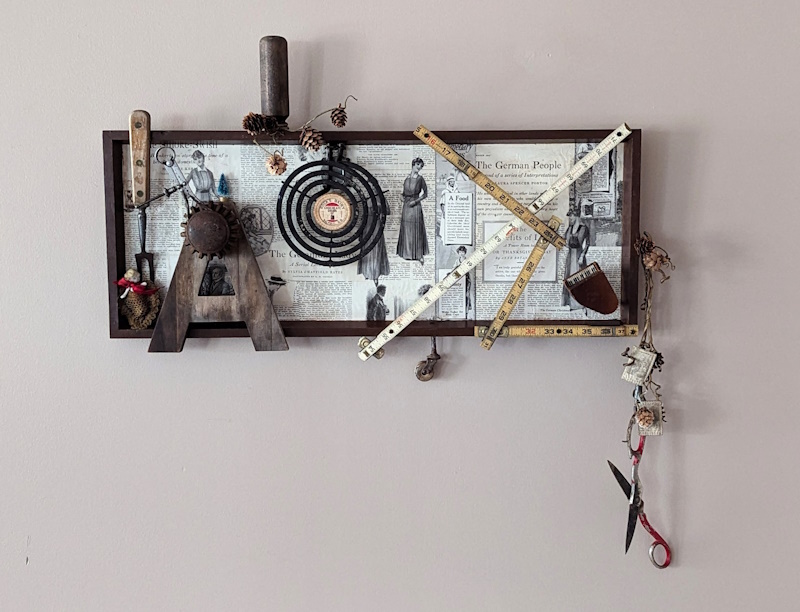In “My Mother’s Scissors,” seemingly ordinary objects like vintage scissors and measuring tape become storytellers, each element weaving together the nuanced tale of a 1950s homemaker’s daily life. This blog delves into how these artifacts not only represent her routine but also echo her distinct personality and the era’s cultural dynamics.
“My Mother’s Scissors” disassembles the mundane and reassembles it into a narrative, inviting observers to look beyond the surface. This work marks a significant departure from my previous creations, largely due to my deliberate and carefully crafted choices. While this piece might appear as a spontaneous assembly of unrelated objects, it was, in fact, meticulously planned. Through careful selection, I crafted a story that reflects my mother’s experience as a 1950s homemaker, grappling with everyday tasks such as making meals, sewing, adhering to the fashion of the times, decorating the home, engaging in hobbies, and caring for her family. This piece aims to convey these daily experiences while also revealing the often-overlooked complexities of a “good housewife.” My mother was more than just pearls and an apron—she was a woman of eclectic style and sensibility.
I created “My Mother’s Scissors” to communicate that there was more to her than the stereotype of having dinner ready by 6 PM, hair perfectly coiffed and heels on. This artwork carries a sense of mystery; it hints at deeper layers hidden beneath the initial impression. It represents a pivotal shift in my artistic style, embodying a blend of assemblage and storytelling that provokes more questions than answers. The eerie, liminal stillness achieved through just the right combination of objects and images, from vintage scissors to measuring tape, not only echoes history but also signifies a break from my traditional approach to art. In this piece, I have forged a new language at the intersection of assemblage and narrative, creating “An Intersection of Assemblage and Narrative.”
This artwork embodies the word “journey” not just in the physical sense of objects traveling through time, but also in the emotional trajectory of uncovering layers of personal and family history. It is a testament to the journey of understanding and appreciating the depths of human experience through the artifacts of our lives. This expression and exploration are what I call “An Intersection of Assemblage and Narrative,” a space where each piece tells its own part of a larger story, each element a crucial part of the emotional and historical landscape.
By stepping into this artistic evolution, “My Mother’s Scissors” showcases “An Intersection of Assemblage and Narrative” in a way that challenges and enriches the viewer’s perception, inviting them to partake in this journey of discovery. This approach not only highlights the complexity of my mother’s identity but also the intricate process of blending storytelling with artistic assembly, creating a unique dialogue between the past and the present.


